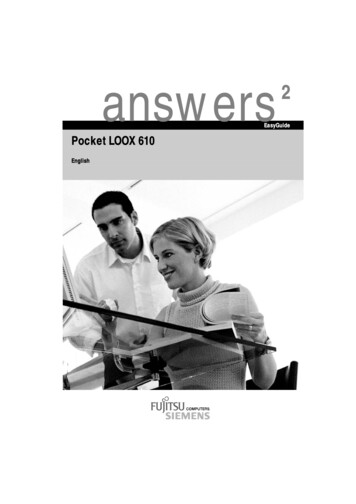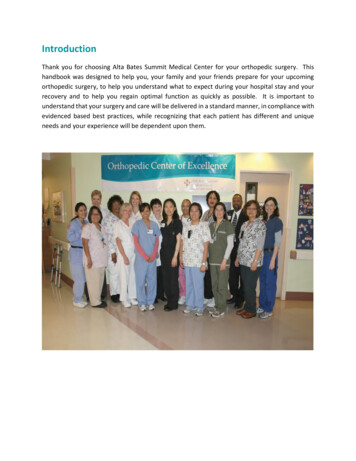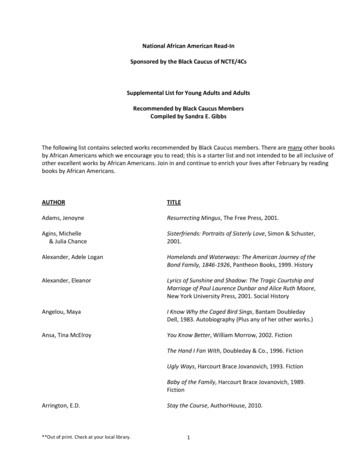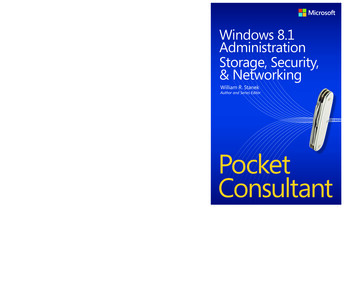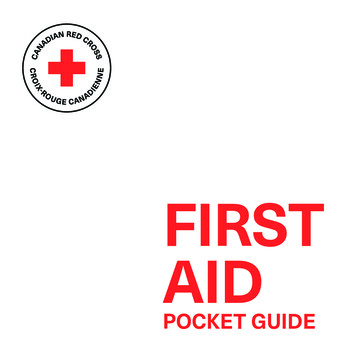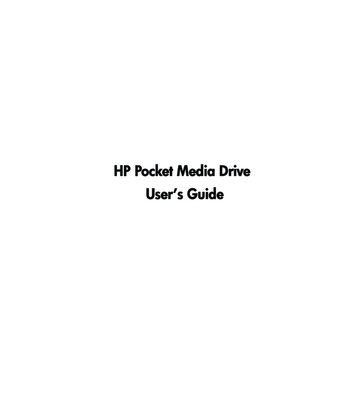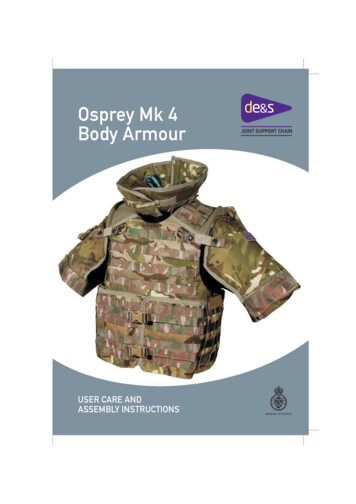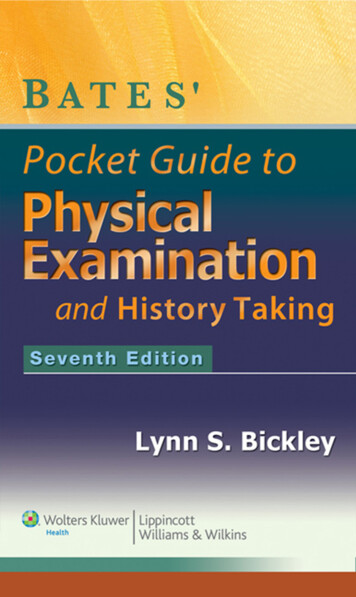
Transcription
Lynn S. Bickley, MD, FACPClinical Professor of Internal MedicineSchool of MedicineUniversity of New MexicoAlbuquerque, New MexicoPeter G. Szilagyi, MD, MPHProfessor of PediatricsChief, Division of General PediatricsUniversity of Rochester School of Medicine and DentistryRochester, New York
Acquisitions Editor: Elizabeth Nieginski/Susan RhynerProduct Manager: Annette FerranEditorial Assistant: Ashley FischerDesign Coordinator: Joan WendtArt Director, Illustration: Brett MacNaughtonManufacturing Coordinator: Karin DuffieldIndexer: Angie AllenPrepress Vendor: Aptara, Inc.7th EditionCopyright 2013 Wolters Kluwer Health Lippincott Williams & Wilkins.Copyright 2009 by Wolters Kluwer Health Lippincott Williams & Wilkins. Copyright 2007,2004, 2000 by Lippincott Williams & Wilkins. Copyright 1995, 1991 by J. B. Lippincott Company.All rights reserved. This book is protected by copyright. No part of this book may be reproduced ortransmitted in any form or by any means, including as photocopies or scanned-in or other electroniccopies, or utilized by any information storage and retrieval system without written permission from thecopyright owner, except for brief quotations embodied in critical articles and reviews. Materials appearing in this book prepared by individuals as part of their official duties as U.S. government employeesare not covered by the above-mentioned copyright. To request permission, please contact LippincottWilliams & Wilkins at Two Commerce Square, 2001 Market Street, Philadelphia PA 19103, via emailat permissions@lww.com or via website at lww.com (products and services).9 8 7 6 5 4 3 2 1Printed in ChinaLibrary of Congress Cataloging-in-Publication DataBickley, Lynn S.Bates’ pocket guide to physical examination and history taking / Lynn S. Bickley,Peter G. Szilagyi. — 7th ed.p. ; cm.Pocket guide to physical examination and history takingAbridgement of: Bates’ guide to physical examination and history-taking. 11th ed. / Lynn S.Bickley, Peter G. Szilagyi. c2013.Includes bibliographical references and index.Summary: “This concise pocket-sized guide presents the classic Bates approach to physical examination and history taking in a quick-reference outline format. It contains all the critical informationneeded to obtain a clinically meaningful health history and to conduct a thorough physical assessment.Fully revised and updated, the Seventh Edition will help health professionals elicit relevant facts fromthe patient’s history, review examination procedures, highlight common findings, learn special assessment techniques, and sharpen interpretive skills.The book features a vibrant full-color art programand an easy-to-follow two-column format with step-by-step examination techniques on the left andabnormalities with differential diagnoses on the right.”—Provided by publisher.ISBN 978-1-4511-7322-2 (pbk. : alk. paper)I. Bates, Barbara, 1928-2002. II. Szilagyi, Peter G. III. Bickley, Lynn S. Bates’ guide to physicalexamination and history-taking. IV. Title. V. Title: Pocket guide to physical examination and history taking.[DNLM: 1. Physical Examination—methods—Handbooks. 2. Medical History Taking—methods—Handbooks. WB 39]616.07′51—dc232012030529Care has been taken to confirm the accuracy of the information presented and to describe generally accepted practices. However, the authors, editors, and publisher are not responsible for errorsor omissions or for any consequences from application of the information in this book and make nowarranty, expressed or implied, with respect to the currency, completeness, or accuracy of the contentsof the publication. Application of this information in a particular situation remains the professionalresponsibility of the practitioner; the clinical treatments described and recommended may not be considered absolute and universal recommendations.The authors, editors, and publisher have exerted every effort to ensure that drug selection anddosage set forth in this text are in accordance with the current recommendations and practice at thetime of publication. However, in view of ongoing research, changes in government regulations, andthe constant flow of information relating to drug therapy and drug reactions, the reader is urged tocheck the package insert for each drug for any change in indications and dosage and for added warnings and precautions. This is particularly important when the recommended agent is a new or infrequently employed drug.Some drugs and medical devices presented in this publication have Food andDrug Administration (FDA) clearance for limited use in restricted research settings. It is the responsibility of the health care provider to ascertain the FDA status of each drug or device planned for use inhis or her clinical practice.LWW.COM
To Randolph B. Schiffer, for lifelong care and support,and to students world-wide committed to clinical excellence.
IntroductionThe Pocket Guide to Physical Examination and History Taking,7th edition is a concise, portable text that: Describes how to interview the patient and take the health history.Provides an illustrated review of the physical examination.Reminds students of common, normal, and abnormal physicalfindings.Describes special techniques of assessment that students may need inspecific instances.Provides succinct aids to interpretation of selected findings.There are several ways to use the Pocket Guide: To review and remember the content of a health history.To review and rehearse the techniques of examination. This can bedone while learning a single section and again while combining theapproaches to several body systems or regions into an integratedexamination (see Chap. 1).To review common variations of normal and selected abnormalities.Observations are keener and more precise when the examiner knowswhat to look, listen, and feel for.To look up special techniques as the need arises. Maneuvers suchas The Timed Get Up and Go test are included in the SpecialTechniques sections in each chapter.To look up additional information about possible findings, includingabnormalities and standards of normal.The Pocket Guide is not intended to serve as a primary text for learning the skills of history taking or physical examination. Its detail is toobrief for these purposes. It is intended instead as an aid for studentreview and recall and as a convenient, brief, and portable reference.vii
Contents 0)8 -:1Overview: Physical Examinationand History Taking 1 0)8 -:2Clinical Reasoning, Assessment, andRecording Your Findings 15 0)8 -:34Interviewing and the Health History 31 0)8 -:5 0)8 -: 6 0)8 -: 7 0)8 -: 8 0)8 -: 9 0)8 -: 10 0)8 -: 11 0)8 -: 12 0)8 -: 13 0)8 -: 14 0)8 -: 15 0)8 -: 16 0)8 -: 17 0)8 -: 18 0)8 -: 0)8 -: 0)8 -:1920Beginning the Physical Examination: GeneralSurvey, Vital Signs, and Pain 49Behavior and Mental Status 67The Skin, Hair, and Nails 83The Head and Neck 99The Thorax and Lungs 127The Cardiovascular System 147The Breasts and Axillae 167The Abdomen179The Peripheral Vascular System 199Male Genitalia and Hernias 211Female Genitalia225The Anus, Rectum, and Prostate 241The Musculoskeletal System 251The Nervous System 285Assessing Children: Infancy ThroughAdolescence 323The Pregnant WomanThe Older Adult359373Index 395ix
CHAPTEROverview: PhysicalExamination andHistory Taking1This chapter provides a road map to clinical proficiency in two criticalareas: the health history and the physical examination.For adults, the comprehensive history includes Identifying Dataand Source of the History, Chief Complaint(s), Present Illness, PastHistory, Family History, Personal and Social History, and Review ofSystems. New patients in the office or hospital merit a comprehensivehealth history; however, in many situations, a more flexible focused,or problem-oriented, interview is appropriate. The components of thecomprehensive health history structure the patient’s story and theformat of your written record, but the order shown below shouldnot dictate the sequence of the interview. The interview is morefluid and should follow the patient’s leads and cues, as described inChapter 3.Overview: Components of the Adult Health HistoryIdentifying DataReliabilityChief Complaint(s) Identifying data—such as age, gender, occupation,marital status Source of the history—usually the patient, but can bea family member or friend, letter of referral, or themedical record If appropriate, establish source of referral because awritten report may be needed Varies according to the patient’s memory, trust, andmood The one or more symptoms or concerns causing thepatient to seek care(continued)1
2Bates’ Pocket Guide to Physical Examination and History TakingOverview: Components of the Adult Health History (continued)Present IllnessPast HistoryFamily HistoryPersonal and SocialHistoryReview of Systems Amplifies the Chief Complaint; describes how eachsymptom developed Includes patient’s thoughts and feelings about theillness Pulls in relevant portions of the Review of Systems,called “pertinent positives and negatives” (see p. 3) May include medications, allergies, habits of smokingand alcohol, which frequently are pertinent to thepresent illness Lists childhood illnesses Lists adult illnesses with dates for at least fourcategories: medical, surgical, obstetric/gynecologic,and psychiatric Includes health maintenance practices such asimmunizations, screening tests, lifestyle issues, andhome safety Outlines or diagrams age and health, or age and causeof death, of siblings, parents, and grandparents Documents presence or absence of specific illnessesin family, such as hypertension, coronary arterydisease, etc. Describes educational level, family of origin, currenthousehold, personal interests, and lifestyle Documents presence or absence of common symptoms related to each major body systemBe sure to distinguish subjective from objective data. Decide if yourassessment will be comprehensive or focused.Subjective DataObjective DataWhat the patient tells youWhat you detect during the examinationThe history, from Chief Complaint All physical examination findingsthrough Review of SystemsTheThee ComprehensiveCompreeheensivve AdultAduult HealthHeealth HiHistoryistoryyAs you elicit the adult health history, be sure to include the following:date and time of history; identifying data, which include age, gender,marital status, and occupation; and reliability, which reflects the qualityof information the patient provides.
Chapter 1 Overview: Physical Examination and History Taking3CHIEF COMPLAINT(S)Quote the patient’s own words. “My stomach hurts and I feel awful”;or “I have come for my regular check-up.”PRESENT ILLNESSThis section is a complete, clear, and chronologic account of the problems prompting the patient to seek care. It should include the problem’s onset, the setting in which it has developed, its manifestations,and any treatments.Every principal symptom should be well characterized, with descriptions of the seven features listed below and pertinent positives andnegatives from relevant areas of the Review of Systems that help clarifythe differential diagnosis.The Seven Attributes of Every Symptom LocationQualityQuantity or severityTiming, including onset, duration, and frequencySetting in which it occursAggravating and relieving factorsAssociated manifestationsIn addition, list medications, including name, dose, route, and frequencyof use; allergies, including specific reactions to each medication; tobaccouse; and alcohol and drug use.HISTORYList childhood illnesses, then list adult illnesses in each of four areas: Medical (e.g., diabetes, hypertension, hepatitis, asthma, HIV),with dates of onset; also information about hospitalizationswith dates; number and gender of sexual partners; risky sexualpractices Surgical (dates, indications, and types of operations)
4Bates’ Pocket Guide to Physical Examination and History Taking Obstetric/gynecologic (obstetric history, menstrual history, birthcontrol, and sexual function) Psychiatric (illness and time frame, diagnoses, hospitalizations, andtreatments)Also discuss Health Maintenance, including immunizations, such astetanus, pertussis, diphtheria, polio, measles, rubella, mumps, influenza,varicella, hepatitis B, Haemophilus influenzae type b, pneumococcalvaccine, and herpes zoster vaccine; and screening tests, such as tuberculin tests, Pap smears, mammograms, stool tests, for occult bloodcolonoscopy, and cholesterol tests, together with the results and thedates they were last performed.FAMILY HISTORYOutline or diagram the age and health, or age and cause of death, ofeach immediate relative, including grandparents, parents, siblings,children, and grandchildren. Record the following conditions as eitherpresent or absent in the family: hypertension, coronary artery disease, elevated cholesterol levels, stroke, diabetes, thyroid or renal disease, cancer(specify type), arthritis, tuberculosis, asthma or lung disease, headache,seizure disorder, mental illness, suicide, alcohol or drug addiction, andallergies, as well as conditions that the patient reports.PERSONAL AND SOCIAL HISTORYInclude occupation and the last year of schooling; home situation andsignificant others; sources of stress, both recent and long term; important life experiences, such as military service; leisure activities; religiousaffiliation and spiritual beliefs; and activities of daily living (ADLs).Also include lifestyle habits such as exercise and diet, safety measures,and alternative health care practices.REVIEW OF SYSTEMS (ROS)These “yes/no” questions go from “head to toe” and conclude the interview. Selected sections can also clarify the Chief Complaint; for example,the respiratory ROS helps characterize the symptom of cough. Start witha fairly general question. This allows you to shift to more specific questions about systems that may be of concern. For example, “How are yourears and hearing?” “How about your lungs and breathing?” “Any trouble
Overview: Physical Examination and History TakingChapter 15with your heart?” “How is your digestion?” The Review of Systems questions may uncover problems that the patient overlooked. Remember to movemajor health events to the Present Illness or Past History in your write-up.Some clinicians do the Review of Systems during the physical examination.If the patient has only a few symptoms, this combination can be efficientbut may disrupt the flow of both the history and the examination.General. Usual weight, recent weight change, clothing that fitsmore tightly or loosely than before; weakness, fatigue, fever.Skin. Rashes, lumps, sores, itching, dryness, color change; changesin hair or nails; changes in size or color of moles.Head, Eyes, Ears, Nose, Throat (HEENT). Head: Headache, headinjury, dizziness, lightheadedness. Eyes: Vision, glasses or contactlenses, last examination, pain, redness, excessive tearing, double orblurred vision, spots, specks, flashing lights, glaucoma, cataracts.Ears: Hearing, tinnitus, vertigo, earache, infection, discharge. If hearing is decreased, use or nonuse of hearing aid. Nose and sinuses: Frequent colds, nasal stuffiness, discharge or itching, hay fever, nosebleeds,sinus trouble. Throat (or mouth and pharynx): Condition of teethand gums; bleeding gums; dentures, if any, and how they fit; last dentalexamination; sore tongue; dry mouth; frequent sore throats; hoarseness.Neck.Lumps, “swollen glands,” goiter, pain, stiffness.Breasts. Lumps, pain or discomfort, nipple discharge, self-examinationpractices.Respiratory. Cough, sputum (color, quantity), hemoptysis, dyspnea,wheezing, pleurisy, last chest x-ray. You may wish to include asthma,bronchitis, emphysema, pneumonia, and tuberculosis.Cardiovascular. “Heart trouble,” hypertension, rheumatic fever,heart murmurs, chest pain or discomfort, palpitations, dyspnea,orthopnea, paroxysmal nocturnal dyspnea, edema, past electrocardiographic or other cardiovascular tests.Gastrointestinal. Trouble swallowing, heartburn, appetite, nausea.Bowel movements, color and size of stools, change in bowel habits,rectal bleeding or black or tarry stools, hemorrhoids, constipation,diarrhea. Abdominal pain, food intolerance, excessive belching orpassing of gas. Jaundice, liver or gallbladder trouble, hepatitis.
6Bates’ Pocket Guide to Physical Examination and History TakingPeripheral Vascular. Intermittent claudication; leg cramps; varicoseveins; past clots in veins; swelling in calves, legs, or feet; color change infingertips or toes during cold weather; swelling with redness or tenderness.Urinary. Frequency of urination, polyuria, nocturia, urgency, burning or pain on urination, hematuria, urinary infections, kidney stones,incontinence; in males, reduced caliber or force of urinary stream,hesitancy, dribbling.Genital.Male: Hernias, discharge from or sores on penis, testicular pain or masses, history of sexually transmitted infections (STIs) ordiseases (STDs) and treatments, testicular self-examination practices.Sexual habits, interest, function, satisfaction, birth control methods,condom use, problems. Concerns about HIV infection. Female: Ageat menarche; regularity, frequency, and duration of periods; amount ofbleeding, bleeding between periods or after intercourse, last menstrualperiod; dysmenorrhea, premenstrual tension. Age at menopause, menopausal symptoms, postmenopausal bleeding. In patients born before1971, exposure to diethylstilbestrol (DES) from maternal use duringpregnancy. Vaginal discharge, itching, sores, lumps, STIs and treatments. Number of pregnancies, number and type of deliveries, numberof abortions (spontaneous and induced), complications of pregnancy,birth control methods. Sexual preference, interest, function, satisfaction,problems (including dyspareunia). Concerns about HIV infection.Musculoskeletal. Muscle or joint pain, stiffness, arthritis, gout,backache. If present, describe location of affected joints or muscles,any swelling, redness, pain, tenderness, stiffness, weakness, or limitation of motion or activity; include timing of symptoms (e.g., morning or evening), duration, and any history of trauma. Neck or lowback pain. Joint pain with systemic features such as fever, chills, rash,anorexia, weight loss, or weakness.Psychiatric. Nervousness; tension; mood, including depression,memory change, suicide attempts, if relevant.Neurologic. Changes in mood, attention, or speech; changes in orientation, memory, insight, or judgment; headache, dizziness, vertigo;fainting, blackouts, seizures, weakness, paralysis, numbness or loss ofsensation, tingling or “pins and needles,” tremors or other involuntarymovements, seizures.Hematologic.Anemia, easy bruising or bleeding, past transfusions,transfusion reactions.
Chapter 1 Overview: Physical Examination and History Taking7Endocrine. “Thyroid trouble,” heat or cold intolerance, excessivesweating, excessive thirst or hunger, polyuria, change in glove or shoe size.TheTheePPhysicalhysiical Examination:Exaaminnattioon:ApproachApprroacch andannd OOverviewveervieewConduct a comprehensive physical examination on most new patients orpatients being admitted to the hospital. For more problem-oriented, orfocused, assessments, the presenting complaints will dictate which segmentsyou elect to perform. The key to a thorough and accurate physical examination is a systematic sequence of examination. With effort and practice, you willacquire your own routine sequence. This book recommends examining from the patient’s right side. Apply the techniques of inspection, palpation, auscultation, and percussion to each body region, but be sensitive to the whole patient. Minimize the number of times you ask the patient to change positionfrom supine to sitting, or standing to lying supine. For an overview of the physical examination, study the sequencethat follows. Note that clinicians vary in where they place differentsegments, especially for the musculoskeletal and nervous systems.BEGINNING THE EXAMINATION:SETTING THE STAGETake the following steps to prepare for the physical examination.Preparing for the Physical Examination Reflect on your approach to the patient.Adjust the lighting and the environment.Make the patient comfortable.Determine the scope of the examination.Choose the sequence of the examination.Observe the correct examining position (the patient’s right side) and handedness.Think through your approach, your professional demeanor, and howto make the patient comfortable and relaxed. Always wash your handsin the patient’s presence before beginning the examination.
8Bates’ Pocket Guide to Physical Examination and History TakingThe Physical Examination: Suggested Sequence and Positioning General survey Vital signs Skin: upper torso, anterior andposterior Head and neck, includingthyroid and lymph nodes Optional: Nervous system(mental status, cranialnerves, upper extremity motorstrength, bulk, tone, cerebellarfunction) Thorax and lungs Breasts Musculoskeletal as indicated:upper extremities Cardiovascular, including JVP,carotid upstrokes and bruits,PMI, etc. Cardiovascular, for S3 andmurmur of mitral stenosis Nervous system: lowerextremity motor strength,bulk, tone, sensation;reflexes; Babinskis Musculoskeletal, as indicated Optional: Skin, anterior andposterior Optional: Nervous system,including gait Optional: Musculoskeletal,comprehensive Women: Pelvic and rectalexamination Men: Prostate and rectalexamination Cardiovascular, for murmur ofaortic insufficiency Optional: Thorax and lungs—anterior Breasts and axillae Abdomen Peripheral vascular; Optional:Skin—lower torso andextremitiesKey to the Symbols for the Patient’s PositionSittingLying supine, with headof bed raised 30 degreesSame, turned partly toleft sideStandingLying supine, with hips flexed,abducted, and externally rotated,and knees flexed (lithotomyposition)Lying on the left side (left lateraldecubitus)Sitting, leaning forwardLying supineEach symbol pertains until a new one appears. Two symbols separated by a slashindicate either or both positions.
Chapter 1 Overview: Physical Examination and History Taking9Reflect on Your Approach to the Patient. Identify yourself as astudent. Try to appear calm, organized, and competent, even if youfeel differently. If you forget to do part of the examination, this isnot uncommon, especially at first! Simply examine that area out ofsequence, but smoothly.Adjust Lighting and the Environment. Adjust the bed to aconvenient height (be sure to lower it when finished!). Ask thepatient to move toward you if this makes it easier to do yourphysical examination. Good lighting and a quiet environment areimportant. Tangential lighting is optimal for structures such as thejugular venous pulse, the thyroid gland, and the apical impulse ofthe heart. It throws contours, elevations, and depressions, whethermoving or stationary, into sharper relief.Make the Patient Comfortable. Show concern for privacy andmodesty. Close nearby doors and draw curtains before beginning. Acquire the art of draping the patient with the gown or draw sheetas you learn each examination segment in future chapters. Your goalis to visualize one body area at a time. As you proceed, keep the patient informed, especially when you anticipate embarrassment or discomfort, as when checking for the femoralpulse. Also try to gauge how much the patient wants to know. Make sure your instructions to the patient at each step are courteousand clear. Watch the patient’s facial expression and even ask “Is it okay?” asyou move through the examination.When you have finished, tell the patient your general impressions andwhat to expect next. Lower the bed to avoid risk of falls and raise thebedrails if needed. As you leave, clean your equipment, dispose ofwaste materials, and wash your hands.Determine the Scope of the Examination. Comprehensive orFocused? Choose whether to do a comprehensive or focused examination.
10Bates’ Pocket Guide to Physical Examination and History TakingChoose the Sequence of the Examination. The sequence of theexamination should maximize the patient’s comfort avoid unnecessary changes in position, and enhance the clinician’s efficiency.In general, move from “head to toe.” An important goal as a studentis to develop your own sequence with these principles in mind. SeeChapter 1 of the textbook for a suggested examination sequence.Observe the Correct Examining Position and Handedness. Examinethe patient from the patient’s right side. Note that it is more reliableto estimate jugular venous pressure from the right, the palpating handrests more comfortably on the apical impulse, the right kidney is morefrequently palpable than the left, and examining tables are frequentlypositioned to accommodate a right-handed approach. To examine thesupine patient, you can examine the head, neck, and anterior chest.Then roll the patient onto each side to listen to the lungs, examine theback, and inspect the skin. Roll the patient back and finish the rest ofthe examination with the patient again supine.TheTheeCComprehensiveompreeheensivve AAdultduult l Survey. Continue this survey throughout the patient visit.Observe general state of health, height, build, and sexual development. Note posture, motor activity, and gait; dress, grooming, andpersonal hygiene; and any odors of the body or breath. Watch facialexpressions and note manner, affect, and reactions to persons andthings in the environment. Listen to the patient’s manner of speakingand note the state of awareness or level of consciousness.Vital Signs. Ask the patient to sit on the edge of the bed or examining table, unless this position is contraindicated. Stand in front of thepatient, moving to either side as needed. Measure the blood pressure.Count pulse and respiratory rate. If indicated, measure body temperature.Skin. Observe the face. Identify any lesions, noting their location,distribution, arrangement, type, and color. Inspect and palpate the hairand nails. Study the patient’s hands. Continue to assess the skin as youexamine the other body regions.
Chapter 1 Overview: Physical Examination and History Taking11HEENT.Darken the room to promote pupillary dilation and visibility of the fundi. Head: Examine the hair, scalp, skull, and face.Eyes: Check visual acuity and screen the visual fields. Note positionand alignment of the eyes. Observe the eyelids. Inspect the sclera andconjunctiva of each eye. With oblique lighting, inspect each cornea,iris, and lens. Compare the pupils, and test their reactions to light.Assess extraocular movements. With an ophthalmoscope, inspect theocular fundi. Ears: Inspect the auricles, canals, and drums. Checkauditory acuity. If acuity is diminished, check lateralization (Webertest) and compare air and bone conduction (Rinne test). Nose andsinuses: Examine the external nose; using a light and nasal speculum,inspect nasal mucosa, septum, and turbinates. Palpate for tendernessof the frontal and maxillary sinuses. Throat (or mouth and pharynx):Inspect the lips, oral mucosa, gums, teeth, tongue, palate, tonsils, andpharynx. (You may wish to assess the Cranial Nerves at this point in theexamination.)Neck.Move behind the sitting patient to feel the thyroid gland andto examine the back, posterior thorax, and lungs. Inspect and palpatethe cervical lymph nodes. Note any masses or unusual pulsations in theneck. Feel for any deviation of the trachea. Observe sound and effortof the patient’s breathing. Inspect and palpate the thyroid gland.Back. Inspect and palpate the spine and muscles.Posterior Thorax and Lungs. Inspect and palpate the spine andmuscles of the upper back. Inspect, palpate, and percuss the chest.Identify the level of diaphragmatic dullness on each side. Listen to thebreath sounds; identify any adventitious (or added) sounds, and, ifindicated, listen to transmitted voice sounds (see p. 133).Breasts, Axillae, and Epitrochlear Nodes. The patient is still sitting. Move to the front again. In a woman, inspect the breasts withpatient’s arms relaxed, then elevated, and then with her hands pressedon her hips. In either sex, inspect the axillae and feel for the axillarynodes; feel for the epitrochlear nodes.A Note on the Musculoskeletal System. By now, you have made preliminary observations of the musculoskeletal system, includingthe hands, the upper back, and, in women, the shoulders’ rangeof motion (ROM). Use these observations to decide whether a fullmusculoskeletal examination is warranted: With the patient still sitting,examine the hands, arms, shoulders, neck, and temporomandibularjoints. Inspect and palpate the joints and check their ROM.
12Bates’ Pocket Guide to Physical Examination and History Taking(You may choose to examine upper extremity muscle bulk, tone, strength,and reflexes at this time, or you may decide to wait until later.)Palpate the breasts, while continuing your inspection.Anterior Thorax and Lungs. The patient position is supine.Ask the patient to lie down. Stand at the right side of the patient’s bed.Inspect, palpate, and percuss the chest. Listen to the breath sounds,any adventitious sounds, and, if indicated, transmitted voice sounds.Cardiovascular System. Elevate head of bed to about30 degrees, adjusting as necessary to see the jugular venous pulsations. Observe the jugular venous pulsations, and measure the jugularvenous pressure in relation to the sternal angle. Inspect and palpatethe carotid pulsations. Listen for carotid bruits./Ask the patient to roll partly onto the left side while youlisten at the apex. Then have the patient roll back to supine while youlisten to the rest of the heart. Ask the patient to sit, lean forward, andexhale while you listen for the murmur of aortic regurgitation. Inspectand palpate the precordium. Note the location, diameter, amplitude,and duration of the apical impulse. Listen at the apex and th
Introduction The Pocket Guide to Physical Examination and History Taking, 7th edition is a concise, portable text that: Describes how to interview the patient and take the health history. Provides an illustrated review of the physical examination. Reminds students of common, normal, and abnormal physical findings. D
